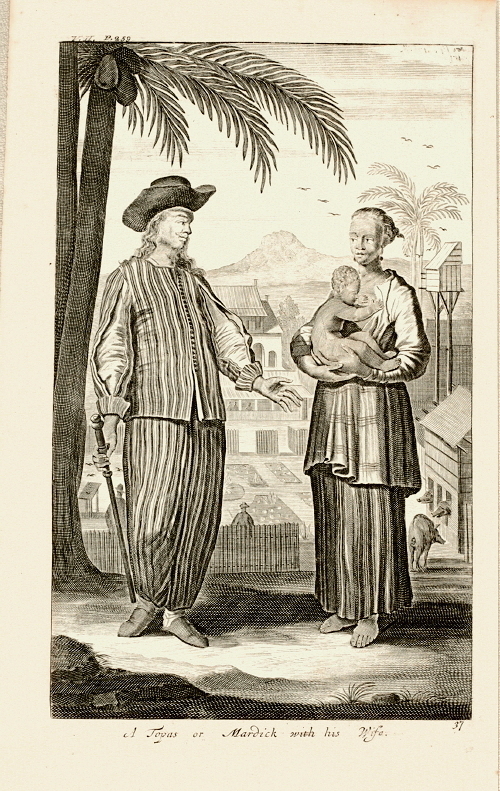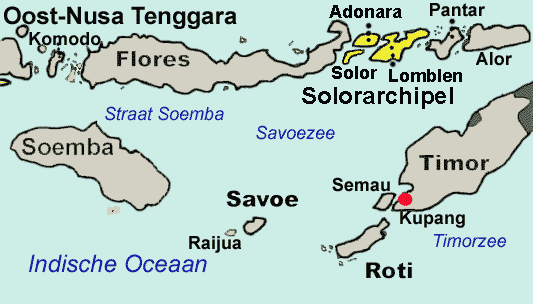|
Kupang City
Kupang ( id, Kota Kupang, ), formerly known as Koepang, is the capital of the Indonesian province of East Nusa Tenggara. At the 2020 C ensus, it had a population of 442,758; the official estimate as at mid 2021 was 455,850. It is the largest city and port on the island of Timor, and is a part of the Timor Leste-Indonesia-Australia Growth Triangle free trade zone. Geographically, Kupang is the southernmost city in Indonesia. History Early history and Portuguese domination Kupang was an important port and trading post during the Portuguese and Dutch colonial eras. There are still ruins and remnants of the colonial presence in the city. Representatives of the Dutch East India Company (VOC) first encountered Kupang in 1613 after having conquered the Portuguese fort on the island of Solor. At this time the area of the city was governed by a Raja of the Helong tribe, who claimed descent from the island of Ceram in the Maluku archipelago. Kupang occupied an ideal strategic ... [...More Info...] [...Related Items...] OR: [Wikipedia] [Google] [Baidu] |
List Of Regencies And Cities Of Indonesia
Regencies (''kabupaten'') and cities (''kota'') are the second-level administrative subdivision in Indonesia, immediately below the provinces, and above the districts. Regencies are roughly equivalent to American counties, although most cities in the United States are below the counties. Following the implementation of decentralization beginning on 1 January 2001, regencies and city municipalities became the key administrative units responsible for providing most governmental services. Each of regencies and cities has their own local government and legislative body. The difference between a regency and a city lies in demography, size, and economy. Generally, a regency comprises a rural area larger than a city, but also often includes various towns. A city usually has non-agricultural economic activities. A regency is headed by a regent (''bupati''), while a city is headed by a mayor (''wali kota''). All regents, mayors, and members of legislatures are directly elected via ele ... [...More Info...] [...Related Items...] OR: [Wikipedia] [Google] [Baidu] |
Sonbai
Sonbai (also spelt ''Sonnebay'', ''Sonba'i'', or ''Sonbait'') was an Indonesian princely dynasty that reigned over various parts of West Timor from at least the 17th century until the 1950s. It was known as the most prestigious princedom of the Atoni people of West Timor, and is the subject of many myths and stories. According to most legends, Sonbai originated from Wehali in the Tetun-speaking central parts of Timor, the classical political and cultural centre of gravitation on Timor. The ancestor of the line, who was a brother of the Liurai (ruler) of Wehali, migrated to the highlands of West Timor, where he married a daughter of a local Atoni lord, Kune, and inherited his lands. The various Atoni principalities tended to relate themselves genealogically to Sonbai, although they did not acknowledge him politically as their lord. Other legends assert that the first Sonbai descended from the sky. Historically, Sonbai is documented in European colonial sources since 1649. At that tim ... [...More Info...] [...Related Items...] OR: [Wikipedia] [Google] [Baidu] |
Topasses
Topasses (Tupasses, Topas, Topaz) were a group of people led by the two powerful families – Da Costa and Hornay – that resided in Oecussi and Flores. The Da Costa families were descendants of Portuguese Jewish merchants and Hornay were Dutch. The origins The etymology of the name is obscure. It might come from the Tamil term ''tuppasi'', "bilingual" or "interpreter". But it has also been associated with the Hindi word ''topi'' (hat) which refers to the characteristic hat worn by the men of this community as a marker of their cultural attachment to the European community. Hence, they are also referred to as ''gente de chapeo'' in Portuguese accounts or as ''gens à chapeau'' in French accounts. It partly overlapped with the Dutch concept mardijker, "free men", who also usually had a Portuguese cultural background, but had no European blood in their veins. While the mardijkers served under the Dutch colonial authorities, the topasses of Timor were staunchly opposed to the ... [...More Info...] [...Related Items...] OR: [Wikipedia] [Google] [Baidu] |
Flores
Flores is one of the Lesser Sunda Islands, a group of islands in the eastern half of Indonesia. Including the Komodo Islands off its west coast (but excluding the Solor Archipelago to the east of Flores), the land area is 15,530.58 km2, and the population was 1,878,875 in the 2020 Census (including various offshore islands); the official estimate as at mid 2021 was 1,897,550. The largest towns are Maumere and Ende. The name ''Flores'' is the Portuguese and Spanish word for "Flowers". Flores is located east of Sumbawa and the Komodo islands, and west of the Solor Islands and the Alor Archipelago. To the southeast is Timor. To the south, across the Sumba Strait, is Sumba island and to the north, beyond the Flores Sea, is Sulawesi. Among all islands containing Indonesian territory, Flores is the 10th most populous after Java, Sumatra, Borneo ( Kalimantan), Sulawesi, New Guinea, Bali, Madura, Lombok, and Timor and also the 10th biggest island of Indonesia. Until the arr ... [...More Info...] [...Related Items...] OR: [Wikipedia] [Google] [Baidu] |
Mestizo
(; ; fem. ) is a term used for racial classification to refer to a person of mixed Ethnic groups in Europe, European and Indigenous peoples of the Americas, Indigenous American ancestry. In certain regions such as Latin America, it may also refer to people who are culturally European even though their ancestors are not. The term was used as an ethnic/racial category for mixed-race that evolved during the Spanish Empire. Although, broadly speaking, means someone of mixed European/Indigenous heritage, the term did not have a fixed meaning in the colonial period. It was a formal label for individuals in official documents, such as censuses, parish registers, Inquisition trials, and others. Priests and royal officials might have classified persons as mestizos, but individuals also used the term in self-identification. The noun , derived from the adjective , is a term for racial mixing that did not come into usage until the twentieth century; it was not a colonial-era term.Rappap ... [...More Info...] [...Related Items...] OR: [Wikipedia] [Google] [Baidu] |
Maluku Islands
The Maluku Islands (; Indonesian: ''Kepulauan Maluku'') or the Moluccas () are an archipelago in the east of Indonesia. Tectonically they are located on the Halmahera Plate within the Molucca Sea Collision Zone. Geographically they are located east of Sulawesi, west of New Guinea, and north and east of Timor. Lying within Wallacea (mostly east of the biogeographical Weber Line), the Maluku Islands have been considered as a geographical and cultural intersection of Asia and Oceania. The islands were known as the Spice Islands because of the nutmeg, mace and cloves that were exclusively found there, the presence of which sparked colonial interest from Europe in the sixteenth century. The Maluku Islands formed a single province from Indonesian independence until 1999, when it was split into two provinces. A new province, North Maluku, incorporates the area between Morotai and Sula, with the arc of islands from Buru and Seram to Wetar remaining within the existing Maluku Province. ... [...More Info...] [...Related Items...] OR: [Wikipedia] [Google] [Baidu] |
Seram Island
Seram (formerly spelled Ceram; also Seran or Serang) is the largest and main island of Maluku province of Indonesia, despite Ambon Island's historical importance. It is located just north of the smaller Ambon Island and a few other adjacent islands, such as Saparua, Haruku, Nusa Laut and the Banda Islands. Geography and geology Seram is traversed by a central mountain range, the highest point of which, Mount Binaiya, is covered with dense rain forests. Its remarkably complex geology is because of its location at the meeting of several tectonic microplates, which have been described as "one of the most tectonically complex areas on Earth". Seram actually falls on its own microplate, which has been twisted around by 80° in the last 8 million years by the relatively faster movement of the Papua microplate. Meanwhile, along with the northward push of the Australian Plate, this has resulted in the uplift that gives north-central Seram peaks of over 3000 m. On the island, there a ... [...More Info...] [...Related Items...] OR: [Wikipedia] [Google] [Baidu] |
Helong People
Helong people are one of the indigenous inhabitants of Timor Island, in Indonesia. Most of them live in Kupang Regency, namely in West Kupang and Central Kupang; and some also settled in Flores Island and Semau Island. Their livelihoods are mainly farming, hunting, fishing, and making traditional crafts. They speak a native language called Helong, which has two dialects, the Helong Semau dialect and the Eastern Land Helong dialect. Helong speakers are found in four villages on the South-Western coast of West Timor, as well as on Semau Island, a small island just off the coast of West Timor. The smallest Helong family system is a nuclear family, which then joins into a limited larger family (''ngalo''). Some ''ngalo'' joins to form a clan (''ingu'') which is led by a clan leader (''koka ana''). In terms of social strata, the ancient Helong community was divided into three layers, the nobility (''usif''), ordinary people (''tob''), and slaves (''ata''). Notable people * Viktor ... [...More Info...] [...Related Items...] OR: [Wikipedia] [Google] [Baidu] |
Raja
''Raja'' (; from , IAST ') is a royal title used for South Asian monarchs. The title is equivalent to king or princely ruler in South Asia and Southeast Asia. The title has a long history in South Asia and Southeast Asia, being attested from the Rigveda, where a ' is a ruler, see for example the ', the "Battle of Ten Kings". Raja-ruled Indian states While most of the Indian salute states (those granted a gun salute by the British Crown) were ruled by a Maharaja (or variation; some promoted from an earlier Raja- or equivalent style), even exclusively from 13 guns up, a number had Rajas: ; Hereditary salutes of 11-guns : * the Raja of Pindrawal * the Raja of Morni * the Raja of Rajouri * the Raja of Ali Rajpur * the Raja of Bilaspur * the Raja of Chamba * the Raja of Faridkot * the Raja of Jhabua * the Raja of Mandi * the Raja of Manipur * the Raja of Narsinghgarh * the Raja of Pudukkottai * the Raja of Rajgarh * the Raja of Sangli * the Raja of Sailana * the Raj ... [...More Info...] [...Related Items...] OR: [Wikipedia] [Google] [Baidu] |
Solor
Solor is a volcanic island located off the eastern tip of Flores island in the Lesser Sunda Islands of Indonesia, in the Solor Archipelago. The island supports a small population that has been whaling for hundreds of years. They speak the languages of Adonara and Lamaholot. There are at least five volcanoes on this island which measures only by . The island's area is , and it had a population of 34,029 at the 2020 Census. The official estimate as at mid 2021 was 35,045. Administrative Districts The island is divided into three districts (''kecamatan''), tabulated below with their areas (in km2) and their populations at the 2010 Census and 2020 Census, together with the official estimates as at mid 2021. The entire island is administered by the East Flores Regency. History of European contact In 1520, the Portuguese established a trading post in the village of Lamakera on the eastern side of the island as a transit harbor between Maluku and Portuguese Malacca. In 1562 ... [...More Info...] [...Related Items...] OR: [Wikipedia] [Google] [Baidu] |







